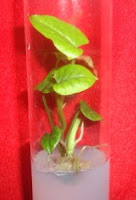
1. Who is the father of tissue
culture?
a) Bonnerb) Haberlandtc) Laibachd) Gautheret
2. The production of secondary metabolites require the use of
a) protoplastb) cell suspensionc) meristemd) auxillary buds
3. Synthetic seed is produced by
encapsulating somatic embryo with
a) sodium chlorideb) sodium alginatec) sodium acetated) sodium nitrate
4. Hormone pair required for a
callus to differentiate are
a) auxin and cytokininb) auxin and ethylenec) auxin and absiccic acidd) cytokinins and gibberllin
5. DMSO (Dimethyl sulfoxide) is
used as
a) Gelling agentb) alkaylating agentc) Chelating agentd) Cryoprotectant
6. The most widely used chemical
for protoplast fusion, as fusogens, is
a) Manitolb) Sorbitolc) Mannold) Poly ethylene glycol (PEG)
7. Cybrids are produced
by
a) Fusion of two different nuclei from two different speciesb) Fusion of two same nuclei from same speciesc) Nucleus of one species but cytoplasm from both the parent speciesd) None of the above
8. Callus is
a) Tissue that forms embryob) An insoluble carbohydratec) Tissue that grows to form embryoidd) Un organised actively dividing mass of cells maintained in cultured
9. Part of plant used for
culturing is called
a) Scionb) Explantc) Stockd) Callus
10. Growth hormone producing
apical dominance is
a) Auxinb) Gibberellinc) Ethylened) Cytokinin
11. A medium which is composed of
chemically defined compound is called
a) Natural mediab) Synthetic mediac) Artificial mediad) None of these
12. To obtain haploid plant, we
culture
a) Entire antherb) Nucleusc) Embryod) Apical bud
13. Somaclonal variations are the
ones
a) Caused by mutagensb) Produce during tissue culturec) Caused by gamma raysd) Induced during sexual embryogeny
14. Which of the following plant
cell will show totipotency?
a) Xylem vesselsb) Sieve tubec) Meristemd) Cork cells
15. Which vector is mostly used in
crop improvement?
a) Plasmidb) Cosmidc) Phasmidd) Agrobacterium
Enroll Now - Understand
the Basics of rDNA Technology in 2 hours
Answers:
- b) Haberlandt
- b) cell suspension
- b) sodium alginate
- a) auxin and cytokinin
- d) Cryoprotectant
- d) Poly ethylene glycol (PEG)
- c) Nucleus of one species but cytoplasm from both the parent species
- d) Un organised actively dividing mass of cells maintained in cultured
- b) Explant
- a) Auxin
- b) Synthetic media
- a) Entire anther
- b) Produce during tissue culture
- c) Meristem
- d) Agrobacterium
Tags:
Callus
Cybrids
DMSO
haploid culture
medium
plant tissue culture mcq
secondary metabolites
Somaclonal variations